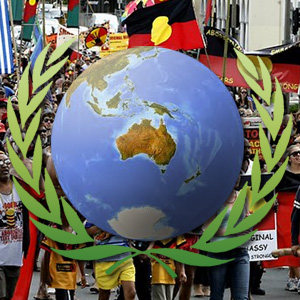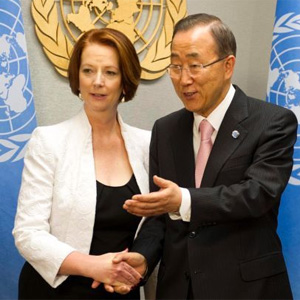UN Security Council push shows up anger at home
![]() See Letter in Full pdf document.
See Letter in Full pdf document.
Fed-up Indigenous Australians won't back country that won't recognise them.
The New Zealand Herald Oct 9, 2012
When the United Nations votes next week on who should occupy two temporary seats on the Security Council, one group of Australians will be cheering for rivals Finland and Luxembourg.
The Sovereign Union of First Nations and Peoples believes Australia has no right to a seat, and has written to UN Secretary-General Ban Ki Moon, the High Commissioner for Human Rights, Navi Pillay, and every accredited ambassador urging rejection of Canberra's bid.
Activist Michael Anderson, one of the founders of the Tent Embassy and the union's chairman, describes Australia as a colonial power in breach of UN conventions, including the Northern Territory intervention's "suspension of any and all human rights" held by indigenous peoples.
The union, which advocates recognition of indigenous sovereign rights and the negotiation of a formal treaty, is at the sharp end of Aboriginal anger and impatience with successive governments.
The anger is deep and pervasive, and felt keenly in Prime Minister Julia Gillard's decision to defer a promised referendum next year on constitutional recognition of indigenous Australians.
Instead, Gillard will ask Parliament to pass an Act of Recognition as an interim measure, acknowledging the "the unique and special place of our first peoples". Limited by a three-year sunset clause, the act is likely to succeed.
The delay followed the failure of efforts to push the referendum above voters' horizons: with less than 40 per cent of the non-Aboriginal population aware of the proposal, there seemed little chance of success.
"The Australian Government agrees with the findings of the expert panel that it is important a referendum is held at a time when it has the most chance of success," Gillard said.
Indigenous reaction ranged from outrage to resignation, steeled with a warning that a referendum must still be held.
Anderson said deferment of constitutional change meant politicians of all stripes and their "negative Aboriginal collaborators" must now face the truth and back calls for negotiating a treaty.
Federal Social Justice Commissioner Mick Gooda acknowledged that a referendum should be held when it stood the best chance of success, but said constitutional recognition must remain the ultimate goal.
"Introduction and passage of [the Act of Recognition] will keep the referendum on the agenda, and if there is a unanimous vote to pass this bill, I think that will help garner the broader community support we need to get this over the line," he said.
Beyond this lies the grim reality of life for Australia's indigenous peoples.
Successive governments have poured billions of dollars into a vast range of programmes, with limited success. Present spending under Labor's Closing the Gap policy includes A$7.1 billion ($8.8 billion) for housing and health, and A$3.4 billion for programmes associated with the controversial NT intervention.
But life expectancy is still about 10 years shorter than for other Australians, infant mortality rates remain higher despite advances, and death rates from heart disease, cancer, and respiratory disease are significantly higher. Indigenous Australians die from diabetes at almost seven times the rate of the rest of the population, and five times higher for kidney disease.
The incidence of communicable diseases such as tuberculosis and hepatitis is also far higher, obesity, smoking, alcohol and drugs are major problems, and high levels of psychological distress are far more common.
The Northern Territory intervention, launched by former Liberal Prime Minister John Howard in 2007 with seeping powers and recently extended by Labor for another decade, remains a major thorn for much of the indigenous population.
Labor's amended "Stronger Futures" intervention laws continue many of Howard's key provisions, but now include compliance with the previously suspended Racial Discrimination Act. Research has shown a number of gains from the intervention but no closure of the gap between Aboriginal and non-indigenous household income or employment.
A health impact assessment of the intervention by the Indigenous Doctors' Association and the University of New South Wales pointed to other problems, among them "profound long-term negative impacts" on psychological health, social health and wellbeing and cultural integrity from external governance and compulsory income management.
The National Congress of Australia's First Peoples, a new peak Aboriginal body part-funded by the federal Government, objects to Labor's extension of the intervention - which it says has not been tested for human rights violations - and points to criticism by the UN High Commissioner for Human Rights and the Special Rapporteur for Indigenous Peoples.
Key among the concerns is income management. This diverts a proportion of welfare payments into special accounts that can be used only to buy priorities such as food, clothing, health items, education and training, child care and housing. Alcohol, tobacco, home brew kits, pornography and gambling are specifically excluded.
Studies have reported gains. Up to 60 per cent of people surveyed said their children's lives had improved and they were less likely to run out of money for essential items.
But there remains widespread anger and opposition to a policy criticised as discriminatory, paternalistic and stigmatising.
And land rights, 20 years after the High Court's Mabo decision that finally rejected the terra nullius (empty land) justification for colonisation, and the subsequent passage of Native Title legislation, remains a burning issue.
"As the hype dissipates over the 'positive achievements' through Native Title laws, we find that our people have gained very little exclusive land title through the process," National Congress co-chair Les Malezer reported. "Economic development beyond temporary employment, training and work experience has not occurred."
And the claims process is heavily backlogged, with 400 yet to be determined. In the Kimberley region, the Bunuba people are looking at regaining their traditional land outside the native title process after 14 years on the waiting list.
Indigenous groups say proposed changes to the legislation, designed to streamline and improve the process, do not go far enough. They are angered by the Government's failure to reverse the present onus of proof on claimants, which Federal Court Judge Paul Finn told a native title conference in June was severe and at odds with the moral foundation of the law, requiring claimants to "in effect ... pass through the eye of a needle".
A long road remains ahead.
The outlook for indigenous Australians
Population: 575,552.
Home: Most live in towns and cities, with about 25 per cent in remote areas.
Life expectancy: 67.2 years for men and 72.9 years for women - about 10 years less than other Australians.
Family: Mothers are younger than other Australians, birthweights of their children are lower and infant mortality rates are 1.8 times higher.
General health: Rates for cardiovascular disease are 1.3 times higher, death rates from cancer up to 1.5 times higher, and for respiratory disease 2.3 times higher.
Disease: Indigenous people die from diabetes at almost seven times the rate of other Australians, and from kidney disease five times the national rate.
Mental health: They are twice as likely to be admitted to hospitals for mental and behavioural disorders, and have a suicide rate 2.5 times higher than other Australians.
First Nation peoples and colonisation
1606
Dutch explorer Willem Jansz is the first European to meet indigenous Australians at Cape York Peninsula, resulting in violence.
1770
Captain James Cook claims the east coast of what was later called Australia, for Britain.
1778
Penal colony established at Sydney Cove, clashing with local Aboriginal people.
1779
First punitive expedition launched against Aborigines, beginning a century of skirmishes, pitched battles, massacres and guerrilla warfare.
1810
First movement of Aboriginal people on to mission stations.
1901
Federation and a new constitution specifically excluding indigenous peoples from census counts and federal laws. They are also banned from voting, pensions and other forms of government service.
1937
Policy of assimilation agreed by federal and state governments: "mixed race" Aboriginals to be compulsorily moved to white society, others to live on reserves.
1948
Indigenous people federally recognised as Australian citizens, with conditional federal voting rights passed the following year.
1967
Referendum gives federal government the power to legislate for Aboriginal people and to include them in the census. All states except Queensland end legal discrimination against Aboriginal people.
1971
Census includes 'Indigenous Australians' for the first time.
1975
Federal Racial Discrimination Act passed.
1976
Aboriginal Land Rights Act passed recognising Aboriginal land ownership in the Northern Territory.
1992
High Court of Mabo rules against "terra nullius" and finds that Aboriginal Sovereignty has not been extinguished with Native Title introduced later.
2008
Prime Minister Kevin Rudd apologises to the Stolen Generation of First Nations people forcibly removed from their families.



